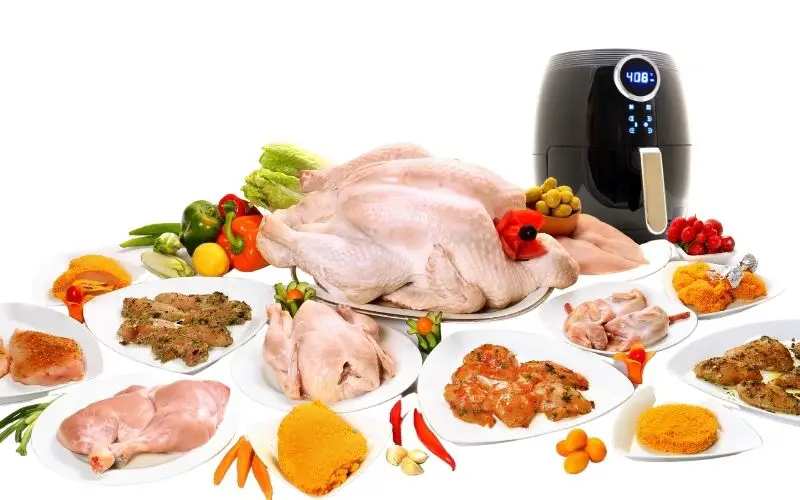Can You Get Salmonella From an Air Fryer? (Completely Explained)
Can you get Salmonella from an air fryer?
Salmonella comes from raw or undercooked poultry. According to the USDA, chicken must reach an internal temperature of at least 165 degrees F. Chicken undercooked in an air fryer can cause salmonella poisoning. Fortunately, there are plenty of ways to avoid it.
Many people believe some frozen chicken dinners are precooked and only need to be heated in the air fryer when they are actually raw. It’s important to check the label and follow the cooking instructions.
Can bacteria grow inside an air fryer?
Bacteria can grow inside an air fryer if it’s not cleaned properly. This is especially true if raw or undercooked meat comes in contact with the cooking surface and then it’s not cleaned properly.
Check the directions of the model of the super cautious individuals.
When cooking chicken in an air fryer, be sure to cook it at the fryer’s highest temperature for approximately a minute. This should be long enough to kill any remaining bacteria.
Understanding bacteria
Bacteria and viruses are common culprits of food poisoning. Food poisoning can cause illness, hospitalization, and even death. According to foodsafety.gov, some of the top bacteria and viruses found in food include:
- E.coli
- Listeria
- Salmonella
- Norovirus
- Botulism
- Hepatitis A
Where do bacteria come from?
Small microbes and pathogens grow and live in the food we eat. Bacteria like salmonella can be found in foods that come from animals, like meat, cheese, milk, and eggs. These pathogens infect and harm living hosts.
Cooking can destroy these pathogens so they are safe to consume.
What are the symptoms of Salmonella?
Some of the most common symptoms of salmonella include diarrhea, fever, and stomach cramps. Some types of salmonella can cause typhoid fever or paratyphoid fever and even an infection in the blood, bones, urine, joints, and nervous system.
Symptoms appear anywhere from six hours to six days and can last up to a week.
How is Salmonella diagnosed?
Salmonella poisoning may be detected in the body when a lab test is performed on a stool sample, the soft tissues in the body, or body fluids.
The sample is done as a culture that isolates the bacteria and makes it easier to identify or with a culture-independent test that detects the genetic makeup of the bacteria.
How is salmonella treatment?
Most people who get salmonella poisoning recover quickly on their own without any treatment within a few days. An individual with diarrhea should drink plenty of water to prevent dehydration.
Don’t let bacteria grow in the first place
The best way to prevent food-borne illnesses is to prevent the growth of bacteria before it starts. Sanitize all kitchen surfaces with a solution of bleach and water every day, including your salt and pepper shaker.
Also, wash your hands thoroughly before and after touching any raw meat for at least 20 seconds using water and soap.
USDA’s Safe minimum cooking internal temperatures chart
| Food | Minimum Internal Temperature & Rest Time |
|---|---|
| Beef, pork, veal, lamb, chops, roast | 145 °F (62.8 °C) and allow to rest for at least 3 minutes |
| Ground meats | 160 °F (71.1 °C) |
| Ground poultry | 165 °F |
| Ham, fresh or smoked (uncooked) | 145 °F (62.8 °C) and allow to rest for at least 3 minutes |
| Fully cooked ham (reheat) | Reheat cooked hams packaged in USDA-inspected plants to 140 °F (60 °C) and all others to 165 °F (73.9 °C). |
| All poultry (breasts, whole bird, legs, thighs, wings, ground poultry, giblets, and stuffings) | 165 °F (73.9 °C) |
| Eggs | 160 °F (71.1 °C) |
| Fish & shellfish | 145 °F (62.8 °C) |
| Leftovers | 165 °F (73.9 °C) |
| Casseroles | 165 °F (73.9 °C) |
What foods may contain Salmonella?
According to the Food and Drug Administration, nearly all foods have the potential risk of carrying salmonella. This includes raw and uncooked meat, poultry and eggs, unpasteurized milk or raw dairy products, any food contaminated with the feces of animals or people, chocolate, ice cream, and even peanut butter.
Salmonella can infect pet foods and treats, including dog biscuits, bones, rawhide, and hooves, so it’s important to wash your hands after handling them.
How do I know if my chicken has Salmonella?
There’s no way to tell if an uncooked chicken has salmonella. Instead, it’s best to treat all pieces as if they are infected by cooking them completely. Live chickens may show symptoms of salmonella by acting weak, lethargic, and having discolored combs and wattles. They also may not eat as much but have increased thirst.
Can you get sick from not cleaning the air fryer?
By not keeping your air fryer clean after each use, you put yourself at risk for food contamination and illness. It’s important to empty the interior of all crumbs and particles, soak the basket and rub out the interior following the manufacturer’s method of cleaning.
Do air fryers release toxins?
Most air fryers are perfectly safe to use and are much healthier than microwaves and other fast cooking methods.
Those with non-stick baskets may release toxins over time when they are heated, so the best thing to do is choose one with a stainless steel basket. Unlike microwaves, an air fryer doesn’t emit radiation when it cooks. However, sometimes the plastic exterior is made with BPA, which has been known to cause cancer.
Other interesting articles:
